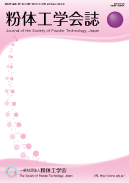
- |<
- <
- 1
- >
- >|
-
 Kizuku Kushimoto, Mika Moriyama, Atsuko Shimosaka, Yoshiyuki Shirakawa ...Article type: Original Paper
Kizuku Kushimoto, Mika Moriyama, Atsuko Shimosaka, Yoshiyuki Shirakawa ...Article type: Original Paper
2019Volume 56Issue 1 Pages 4-14
Published: January 10, 2019
Released on J-STAGE: January 19, 2019
JOURNAL FREE ACCESSA new model for estimating macroscopic permittivity was proposed to predict dispersion states of filler particles in a particulate composite material. In the model, the estimation targets are random packed composite materials. The composite materials were represented as a cluster of unit cells. The unit cells were connected by a proposed layer structure model. The macroscopic permittivity was estimated by calculating a synthetic capacity of the cluster.
The proposed model was validated by comparisons between estimated and measured macroscopic permittivity of several particulate composite materials. In addition, it was identified that the proposed model could estimate the permittivity more accuracy than an existing theoretical equation’s one due to considering the effects for the dispersion states of filler particles. Furthermore, it was indicated that the proposed model could also estimate the dispersion states of filler particles by the measured permittivity. The applicability of the method was confirmed by comparisons between estimated and experimental dispersion states of filler particles.
View full abstractDownload PDF (2368K) -
Yusuke Akimoto, Masaaki Tani, Katsuharu Okuda, Hiroshi NakamuraArticle type: Original Paper
2019Volume 56Issue 1 Pages 15-20
Published: January 10, 2019
Released on J-STAGE: January 19, 2019
JOURNAL FREE ACCESSWhen we measure the size of granulated particles in rolling fluid granulation equipment, we usually measure average size-distribution of them using laser or other optic devices. But now, it is needed measuring the thickness of the liquid-coating on particles more accurately to decide conditions of the granulation more precisely. Here we developed a method to observe directly the particles and its coating in rolling fluid granulation equipment. First, we developed the technique obtaining liquid-coated particles directly from rolling fluid granulation equipment and removing atmosphere-derived moisture. After that all of the liquid on the particles is sublimated. Comparing the size of the particles before and after the sublimation, we obtained the thickness of the liquid-coating on the particles.
View full abstractDownload PDF (4590K)
- |<
- <
- 1
- >
- >|